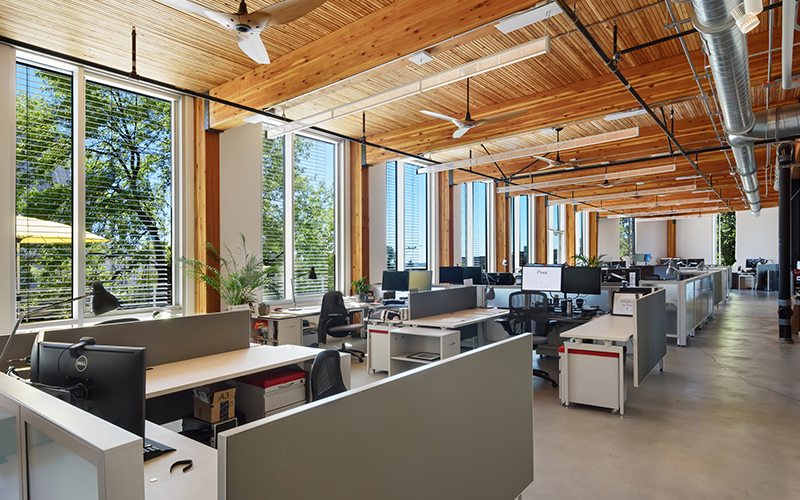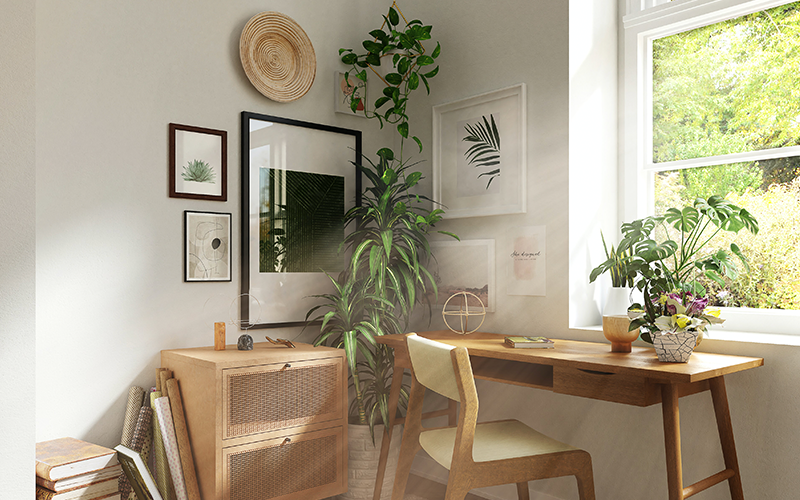This story is part of Fix’s Outdoors Issue, which explores how we build connections to nature, why those connections matter, and how equitable access to outside spaces is a vital climate solution.
Erin Rovalo was playing in a forest of cedar and Douglas fir near Tacoma, Washington, when she came upon a tree that changed her life.
“I have this very vivid memory from my childhood,” she says, “of finding one particular cedar tree that had these long branches that went all the way to the ground.” She and her friends found an opening in the dense greenery and discovered they could squeeze their way through. It was like a hidden door to a mysterious world under the tree’s canopy. The space smelled of “rich-soil earth” and was illuminated by sunlight filtered through the leaves, making patterns on the ground. Being there sparked Rovalo’s sense of wonder and imagination.
Rovalo, who’s vice president of the community department at the International Living Future Institute, is an expert in biomimicry, which looks to nature’s forms and processes to solve design challenges like reducing energy and water consumption, preserving ecosystems, and managing waste. In addition to sustainability, Rovalo is passionate about the psychological element of design inspired by nature. She believes indoor spaces can emulate the cedar tree she treasured — a place of beauty, refuge, and serenity.
“I remember in that moment really feeling like nature can almost be like a room or like a building,” says Rovalo. “Here I am 30 years later trying to make buildings more like nature.”
Bringing nature indoors could go a long way toward improving the country’s physical and mental health. Socio-economic factors like increased urbanization, indoor work, and inequities in access to green space lead Americans to spend 87 percent of their time in buildings, despite the fact research demonstrates that time spent in natural settings can reduce stress and improve physical and mental well-being. The outdoors has also become increasingly inaccessible because of climate change events such as wildfires, extreme temperatures, and storms. While the barriers to being outside must be addressed, social and natural scientists say that making our homes and offices look and feel more like nature can provide some of the benefits of actually being there. And with the right design, the indoors can be a place of refuge and resilience, too.
* * *
Our bodies and minds regularly experience the fight-or-flight response, a physiological reaction to stress that prepares the body to defend itself or run away. It can be triggered by societal challenges like COVID, climate change, and housing instability, or even walking down a noisy, congested street. Remaining in this state for extended periods puts a strain on the body and psyche. But the sights, sounds, smells, and feel of nature activate the parasympathetic nervous system — more commonly known as rest-and-digest mode — which creates feelings of calm and relaxation.
Most people might think “nature” means a forest, a beach, or at the very least a trip to a park — indeed, visiting those places encourages exercise and its associated health benefits. But even the smallest glimpse of the natural world can provide relief from stress.
Rovalo says a state of reflection and restoration can be achieved just by observing “subtle movements, like grass blowing in the wind or shadow play.”
We don’t have to be outdoors to be in this state. Research shows that looking at plants or touching natural materials in the built environment can induce physiological relaxation. Things that mimic nature, like recorded sounds of waves or photographs of a natural landscape, can also produce that effect. Studies also show that contact with nature has a positive impact on the ability to focus — what scientists call attention restoration. Incorporating natural light, views of nature, and indoor plants has improved learning outcomes in schools and increased workplace productivity.
Many scholars attribute these outcomes to a simple phenomenon: biophilia, a term coined by social psychologist Eric Fromm and popularized by biologist Edward O. Wilson in his 1984 book, Biophilia. Wilson believed that humans have an innate tendency to seek connections with nature, and that contact with it sparks joy. “Biophilia literally means the love of life,” says Renee Christensen, director of standard development at the International WELL Building Institute, which has provided a roadmap for the design of thousands of buildings that prioritize mental and physical well-being.
In 1995, Wilson and social ecologist Stephen Kellert co-edited The Biophilia Hypothesis, which gathered science and theory in support of the topic. Building off of this work, biophilia experts Bill Browning and Jenifer Seal-Carmer proposed three categories for biophilic design experiences in the 2008 book Biophilic Design. “Nature in the space” refers to direct experiences of nature in the built environment through plants, sunlight, breezes, fish ponds, fireplaces, fountains, and other features. “Natural analogues” are indirect experiences of nature through building materials like wood and stone, listening to nature sounds, or looking at artwork of nature-scapes. The third category, “nature of the space,” describes design elements like “prospect,” which means you have an unimpeded view throughout a space, and “refuge.” Together, they mimic the protected feeling of looking out over a landscape with your back against a shady tree.
Some of these design concepts overlap with strategies for greener buildings, such as those outlined in the U.S. Green Building Council’s LEED certification. For example, passive solar design that takes advantage of sunlight to heat buildings would, by definition, mean the space features natural light and views to the outside. Organic building materials, such as wood, can have a lower carbon footprint and sometimes act as a carbon sink. And some kinds of interior and exterior greenery, like living walls and green roofs, provide insulation, thereby reducing the energy needed for heating and cooling.

A well-known example of biophilic design is the Bullitt Center in Seattle, which opened in 2013 as the first commercial office building to receive the International Living Future Institute’s Living Building Certificate. (Editor’s note: Grist’s office is located in the Bullitt Center.) It is also the site of ILFI’s office. “Even though you’re in the middle of the city,” says Rovalo, “it feels a little bit like a respite zone.” The ground floor includes tall ceilings and glass walls that overlook a small park. The windows open and close automatically, bringing in fresh air and breeze, and the lobby features a lichen carpet on the walls and a blown-glass light fixture that resembles a flower.
The residential sector also is looking to biophilic interiors. Last year, Lakehouse, a 250,000-square-foot condominium building in Denver, received the WELL Gold Building Certification for its exceptional “mind and nourishment” elements. In addition to ample outdoor spaces, the building is designed to provide a connection to nature through stone and wood building materials, floor-to-ceiling windows, a fireplace in the lounge, and views of the lake or landscaping from most units. Condo owner Michelle Bettis says that when she’s not feeling well, resting indoors with natural light and views is “absolutely delightful.” The flower garden and maple trees right outside her window are “things that give me life.”
Anyone can take a few simple and affordable steps — like keeping houseplants, playing nature sounds, or installing a fountain — to bring biophilic elements into their home.
The movement extends beyond high-end housing. “I am a firm believer that everybody has a right to a safe, supportive place to live,” says Lynne Dearborn, an architect who studies the relationship between people and their built environment at the University of Illinois. Dearborn has met with housing providers like Skid Row Housing Trust in Los Angeles, which integrates social services into its housing complexes along with community gardens and exposed walkways.
In 2022, Thessalonica Court, an affordable apartment building in the Bronx, received the WELL Building Certification, which requires features like natural building materials, ample natural light, and community gardens. It was also certified through Enterprise Green Communities, a national green-building program for affordable housing. WELL and Enterprise worked in partnership, making Thessalonica Court the first building to receive both certifications.
Dearborn argues that many biophilic elements, such as ample daylight and views of nature, are inexpensive and easily incorporated into new construction and renovations. And anyone can take a few simple and affordable steps — like keeping houseplants, playing nature sounds, or installing a fountain — to bring biophilic elements into their home.
* * *
The outdoors is a place of respite and restoration for many, but for those in regions affected by wildfires, extreme temperatures, and storms, it can be a hostile place as well. These climate-related conditions, and the widespread retreat indoors resulting from the COVID pandemic, have dramatically changed the nature of our relationship with the built environment. As such, biophilic design, and its potential to offer refuge and well-being, is becoming a greater part of the conversation within the building sector. “You want somewhere to go that can protect you from the horror that’s happening outside,” says Gayathri Unnikrishnan, vice president of standard development at WELL.

Experts at green design and consulting firm Terrapin Bright Green view interiors that mimic nature as a pathway to healing and resilience for people traumatized by the loss of homes to wildfires or other disasters. “We see biophilic design as a really powerful tool for supporting people’s health and well-being,” says Bill Browning, a co-founding partner. The firm has worked on more than 100 buildings that incorporate biophilic design. He hopes that experiencing this connection to nature “also makes people think about wanting to help preserve nature.”
In the meantime, the research is clear and design interventions are well understood: Scaling up biophilic interiors will have a positive impact on society’s collective well-being, especially if it is accessible to all. To this end, WELL partners with affordable housing developers like Enterprise and offers discounts and incentives for pursuing its certification. ILFI, which has certified 79 buildings as “living buildings” with biophilic design elements, provides a framework and resources for the affordable housing sector. And some states require green design and healthy interiors in affordable housing projects that take advantage of the federal Low-Income Housing Tax Credit (although there is still a way to go in terms of requiring biophilic design). “There’s always going to be more that we need to do between those buildings,” says Unnikrishnan.
Whether it be outdoors or indoors, it is crucial that we bring nature closer to people, says Rovalo. “Having access to nature really is a human birthright.”
Explore more from Fix’s Outdoors Issue:
- From kelp farming to ancient wayfaring: Restoring traditional land practices
- How green infrastructure can benefit frontline communities
- Foraging New York City’s wild, edible margins with Journei Bimwala




